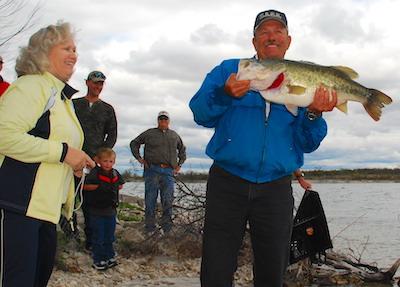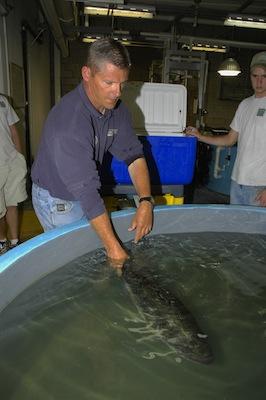
Big bass program unveils new format hoping to hook more anglers
December 29, 2017 - Big changes are coming for Toyota ShareLunker on Jan. 1, more than three decades after Lake Fork fishing guide Mark Stevenson turned over the program's very first entry in November 1986.
In hindsight, Stevenson's 17.67 pound former state record provided a pivotal jump start for the spawning and genetics research program, which is founded on giant Texas bass and the anglers who catch them.
ShareLunker has since taken in 569 additional entries weighing upwards of 13 pounds from more than 60 public reservoirs scattered around the state while operating under a format that rewards participating anglers with cool prizes and widespread recognition through press releases and social media.
 In exchange, TPWD scientists get the green light to pair the big female bass with hand-picked males in hatchery raceways for spawning. The idea is to produce armies of baby bass with shared big bass DNA.
In exchange, TPWD scientists get the green light to pair the big female bass with hand-picked males in hatchery raceways for spawning. The idea is to produce armies of baby bass with shared big bass DNA.
The ShareLunker prodigy are stocked back into Texas lakes or used for research. TPWD hopes to revamp its entire Florida bass hatchery program using ShareLunker offspring within the next few years.
Often billed as one of the most successful public relations programs ever launched by the state agency, ShareLunker has generated a wealth of interest in Texas bass fishing while spurring some really neat findings in fish science along the way.
Not surprisingly, the program has undergone a passel of policy changes over the years, both good and bad. It has also met with a few bumps in the road in recent times that have caused angler support and participation to wane.
Rekindling Interest
New leaders within TPWD's inland fisheries division have been looking for ways to rekindle public interest, restore angler trust and boost participation in ShareLunker for more than a year now. They are hopeful a new format to be launched on New Year's Day will breathe new life into the program and ultimately bring it out of the slump.
According to Craig Bonds, TPWD inland fisheries director, the program was in need of some changes. He and his staff gave it more of a facelift, instead.
"Program enhancements were shaped and implemented using a team approach, including perspectives and contributions from across our inland fisheries disciplines, as well as from a diversity of talented teams within information technology and communications divisions. We solicited and received input from our Texas Freshwater Fisheries Advisory Committee and surveys of targeted bass anglers, such as a subsample of past ShareLunker participants. Our programmatic review began well over a year ago and teams of experts have been working diligently on implementation over the past six months. We're excited about it and we are hopeful that the anglers will be excited about it, too."
Outlining the Changes
ShareLunker has always centered on anglers donating big Texas-caught bass for spawning purposes. Since day one, the minimum size required for entry has been 13 pounds.
Those fish are still considered the heart and soul of the Jan. 1 - March 31 spawning phase of the program under the revised structure. However, TPWD is expanding the format to allow anglers to gain recognition by entering bass as small as eight pounds in other categories year-round.
The idea behind adding more levels of achievement is to drum up more entries while providing researchers with data that will help them get a better grip on trophy bass distribution across the state.
TPWD is putting plenty of bait on the table to spur angler interest, too. Among the incentives are automatic chances to win $5,000 shopping sprees to an outdoor retailer, fishing licenses, ShareLunker branded merchandise, fishing tackle packages, etc.
The expanded format also includes simplified ways to enter. While 13 pounders used for spawning must be approved on site by TPWD biologists, other entries (including 13 pounders caught outside the spawning window) will be accepted using the new Toyota Sharelunker mobile application or online via the program's new website, texassharelunker.com.
The latter entries must be accompanied by digital photos of the fish being weighed on a digital scale or measured on a rigid measuring board. Fish caught during a tournament must be accompanied by a weigh-in slip or website links for documentation, if photos are not available. TPWD reserves the right to deny any questionable entry.
Another noteworthy change is one that gives anglers the opportunity to become citizen scientists by submitting scale samples from their fish for DNA testing. Testing will be performed at TPWD's genetics lab in San Marcos at no cost to the angler.
"We'll be able to run the scales to determine the genetics of individual fish at our lab," Bond said. "This will not only satisfy the curiosity of the angler, but it will also provide us with valuable data about the genetics of our wild populations of large bass around the state.
"As we move from stocking ten of thousands of selectively-bred offspring to tens of millions in the future, then hopefully we'll start seeing some of these fish show up in scale samples that are submitted to us by the anglers," Bonds added. "It's a citizen science partnership we hope to establish with anglers that will allow them to contribute to the management of largemouth bass in Texas and make it bigger and better."
The newly designed ShareLunker website provides detailed instructions on scale removal, proper handling and entry criteria. Beginning Jan. 1, there will an link on the website that will allow anglers to download the mobile entry app to their smartphones, as well as instructions for submitting digital entry applications and photos online.
Cool as it all sounds, TPWD isn't exploring unchartered territory with its expanded ShareLunker format. The Florida Fish and Wildlife Conservation Commission runs a similar catch and release program called TrophyCatch.
Founded in 2012, the program has several different prize tiers. Every angler who enters a fish that meets program requirements earns a reward. The TrophyCatch program also has a random drawing for a Phoenix bass boat at the end of each season. More than 5,000 entries have been submitted to the program over the last five years.
"The Florida program has been really successful," Bonds said. "It started off with just a few entries the first year, but it has grown exponentially since then. We already have some brand awareness and recognition with the ShareLunker program, but we have no idea how the first year will go. We don't know if we'll shoot out of the starting gate with a lot of entries or if it will grow through time."
It's going to be interesting to how things shake out, for sure.
Matt Williams is a freelance writer based in Nacogdoches. He can be reached by e-mail, mattwillwrite4u@yahoo.com.









